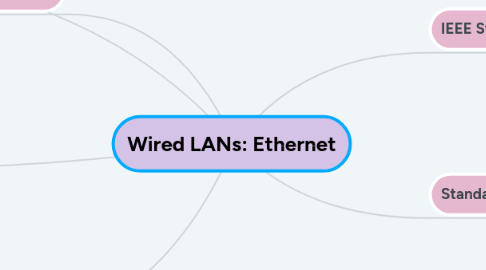Wired LANs: Ethernet
da awang ron


1. Fast Ethernet is a local area network (LAN) transmission standard that provides a data rate of 100 megabits per second (referred to as "100BASE-T"). Workstations with existing 10 megabit per second (10BASE-T) Ethernet card can be connected to a Fast Ethernet network
2. Fast Ethernet
3. Gigabit Ethernet
3.1. MAC Sublayer Physical Layer
3.1.1. PHY Sublayer
3.1.2. Medium-Dependent Interface(MDI)
3.1.3. Reconcilliation Sublayer (RS)
4. Ten- Gigabit Ethernet
4.1. 10 gigabit Ethernet is a telecommunication technology that offers data speeds up to 10 billion bits per second. 10 gigabit Ethernet (10-Gigabit Ethernet) is also known as 10GE, 10GbE or 10 GigE.
4.1.1. • LAN: – both service provider and enterprise • MAN: – both dark fiber and DWDM • WAN: – Attachment to WAN access equipment at edge of OC-192 infrastructure
5. IEEE Standards
5.1. IEEE 802.3 is a working group and a collection of Institute of Electrical and Electronics Engineers (IEEE) standards produced by the working group defining the physical layer and data link layer's media access control (MAC) of wired Ethernet.
5.1.1. Ethernet evolution
5.1.1.1. Standard Ethernet
5.1.1.2. Fast Ethernet
5.1.1.3. Gigabit Ethernet
5.1.1.4. Ten-Gigabit Ethernet
6. Standard Ethernet
6.1. The Ethernet standard (IEEE 802.3u) has been established for Ethernet networks that need higher transmission speeds. This standard raises the Ethernet speed limit from 10 Mbps to 100 Mbps with only minimal changes to the existing cable structure.
6.1.1. MAC Sublayer Physical Layer
6.1.1.1. physical layer signaling(PLS)
6.1.1.2. MDI
6.1.1.3. Medium Attachment Unit(MAU)
6.1.1.4. Attachment unit interface (AUI)

